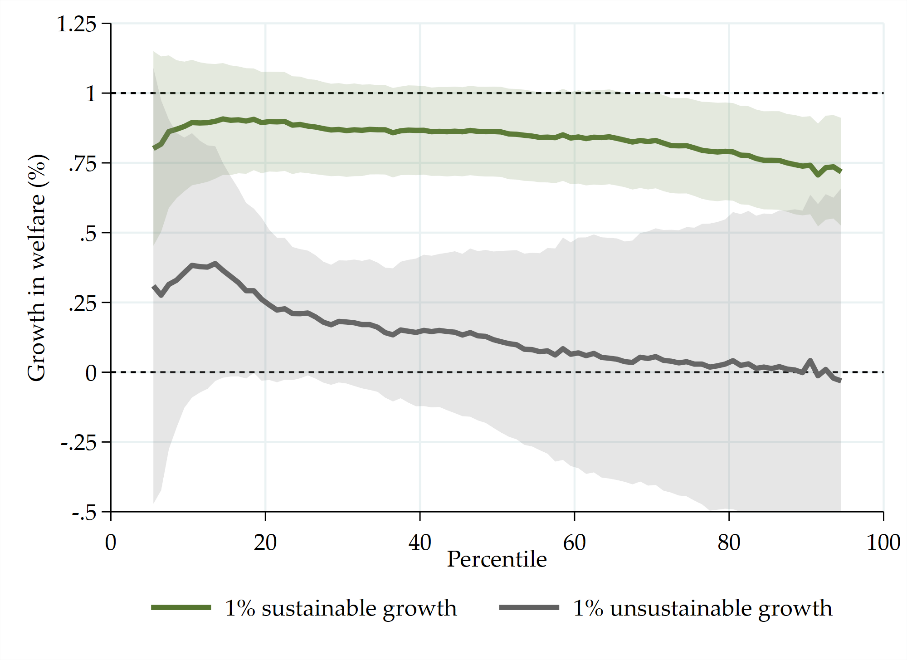
This blog has benefited from discussions with Christoph Lakner, James Cust, Philip Wollburg, and Umar Serajuddin.
The author gratefully acknowledges financial support from the UK Government through the Data and Evidence for Tackling Extreme Poverty (DEEP) Research Program.
The Sustainable Development Goals, through their very name, suggest that development may occur in an unsustainable manner. If sustainability and development always went hand in hand, there would be no need to add a reference to sustainability. The World Bank’s mission stated prominently on its main website – “to end extreme poverty and promote shared prosperity in a sustainable way” – similarly suggests that poverty reduction and shared prosperity can occur in an unsustainable way. If not, adding in a sustainable way would be redundant – a pleonasm – in the same way that describing a circle as round is redundant.
Yet, in the long run the evidence that development can only happen sustainably is overwhelming. The long-run (and, unfortunately, some places already too present) consequences of unsustainable ‘development’ involve catastrophic extreme weather events, millions of climate refugees, millions of people seeing their livelihoods vanishing, and millions of people pushed into famine and extreme poverty. Such a bleak picture of the world is hardly worthy of the term development at all. In the long-run, sustainable development appears to be a pleonasm – development can only happen when sustainability is secured.
The fact that sustainability and development likely go hand in hand in the long run suggests that the need to add sustainability to our global goals might be motivated by short-run or historical concerns. Perhaps some decision makers are willing to ignore the future and lower poverty in the short run by using up natural resources or by excessively emitting greenhouse gasses into the atmosphere. But does such unsustainable growth actually lead to development and poverty reduction, even in the short run?

A combination of data sources makes it possible to tackle this question. The World Bank report, The Changing Wealth of Nations, undertakes the difficult tasks of building comprehensive measures of national wealth to include natural assets and analyzing how these measures change over time. This sheds light on how depletion and unsustainable resource management can subtract from national wealth and be converted into short-run gains in national income.
Building on this data created by The Changing Wealth of Nations, it is possible to decompose total national income into an unsustainable part and a sustainable part. Inspired by their report, I define the unsustainable part of national income as the sum of the value of depletion of natural resources, the cost of damage of national income due to CO2 and particulate emissions, and the consumption of fixed capital. The sustainable part is the residual. Similar accounting exercises that try to correct growth for unsustainable or other unattractive parts have been done in the past, starting with Nordhaus and Tobin’s (1973) measure of economic welfare, which, amongst other things, adjusted total national output for environmental damage.
Combining the data from The Changing Wealth of Nations with microdata for 141 countries from PovcalNet, the World Bank’s database for monitoring global poverty, makes it possible to study whether sustainable or unsustainable growth is conducive to poverty reduction. There is a long history of studying the extent to which economic growth ‘passes through’ to mean welfare as observed in household surveys (see for example Ravallion (2003)) or the welfare of those at the bottom of the distribution (see for example Dollar & Kraay (2002)). With the decomposition of growth into a sustainable part and an unsustainable part, one can study these questions separately for sustainable and unsustainable growth.
In more detail, I attempt to answer the following question: If national income grows by 1% in a(n) (un)sustainable manner, how much of this growth passes down to each part of the distribution? A more formal description of what I do is outlined at the end of the blog.
Impact of 1% sustainable or unsustainable growth on welfare from household surveys

Here is what I find.
For people at the bottom of the distribution, sustainable growth passes through nearly 1:1 to welfare while less than half of unsustainable growth passes through to welfare at the bottom. For people with a median income, when national income grows by 1% in an unsustainable manner, only around one tenth passes through.
There is a lot of uncertainty surrounding the impact of unsustainable growth. This is likely because unsustainable growth on average only makes up a fifth of total growth, and due to unsustainable growth having different impacts on welfare across different settings. Yet, there is significant evidence in favor of sustainable growth having a larger impact on household welfare than unsustainable growth.
It is vital to mention one important disclaimer here: The patterns described above are all associations and need not be causal. It need not be the case that unsustainable growth is causing a smaller growth in welfare than sustainable growth. It could be, for example, that countries with high rates of unsustainable growth also are characterized by higher levels of corruption, and that corruption is the reason why unsustainable growth seemingly trickles down less to welfare as observed in household surveys.
That said, the associations across 141 countries point to it being the case that, historically, unsustainable growth has led to some short-term economic progress of the poorest, but that it has been roughly half as effective as sustainable growth.
This suggests that unsustainable development remains a possibility, or in other words that sustainable development is not a pleonasm. Yet unsustainable growth is less effective at reducing poverty, so decision makers should not place their bets on short term development gains at the expense of environmental degradation. In the short run, such a strategy will be less effective than growing sustainably, and in the long run, it will certainly fail.
The figure is generated from 100 regressions of the following form – one for each percentile of a country’s distribution of welfare as measured in household surveys,
Here the left-hand side measures the annualized growth rate of consumption or income of a particular percentile between two comparable household surveys conducted at time  and
and 
 to the environmentally unsustainable part of national income—defined here as the value of depletion of natural resources, the cost of damage of national income due to CO2 and particulate emissions, and the consumption of fixed capital.
to the environmentally unsustainable part of national income—defined here as the value of depletion of natural resources, the cost of damage of national income due to CO2 and particulate emissions, and the consumption of fixed capital.  is the remainder of GNI. As such, the two fractions in the equation measure the (un)sustainable contribution to national growth measured in percentage points and the betas are estimates of the expected increase in welfare of a given percentile due to a 1% growth stemming exclusively from (un)sustainable sources. Plotting the betas as a function of the percentile reveals how sustainable and unsustainable growth trickle down to welfare at all parts of the distribution. The shaded areas reflect 95th percentile confidence intervals based on standard errors clustered at the country-level.
is the remainder of GNI. As such, the two fractions in the equation measure the (un)sustainable contribution to national growth measured in percentage points and the betas are estimates of the expected increase in welfare of a given percentile due to a 1% growth stemming exclusively from (un)sustainable sources. Plotting the betas as a function of the percentile reveals how sustainable and unsustainable growth trickle down to welfare at all parts of the distribution. The shaded areas reflect 95th percentile confidence intervals based on standard errors clustered at the country-level.



Join the Conversation